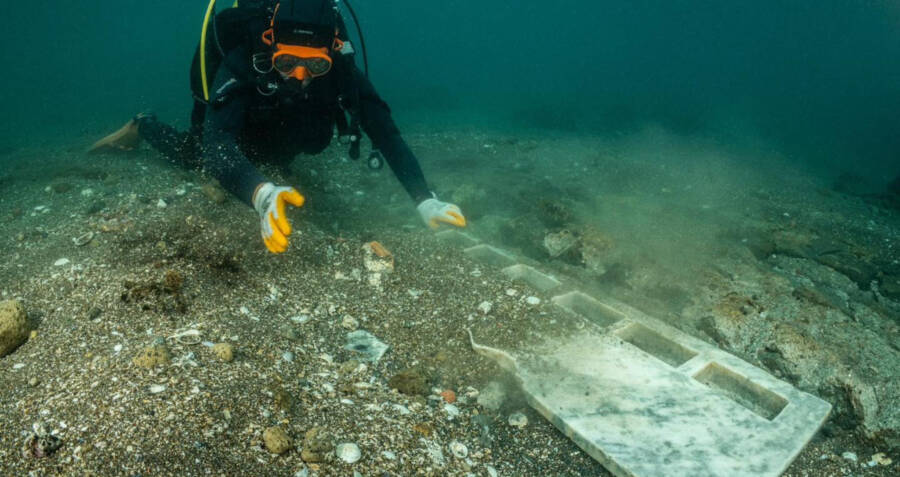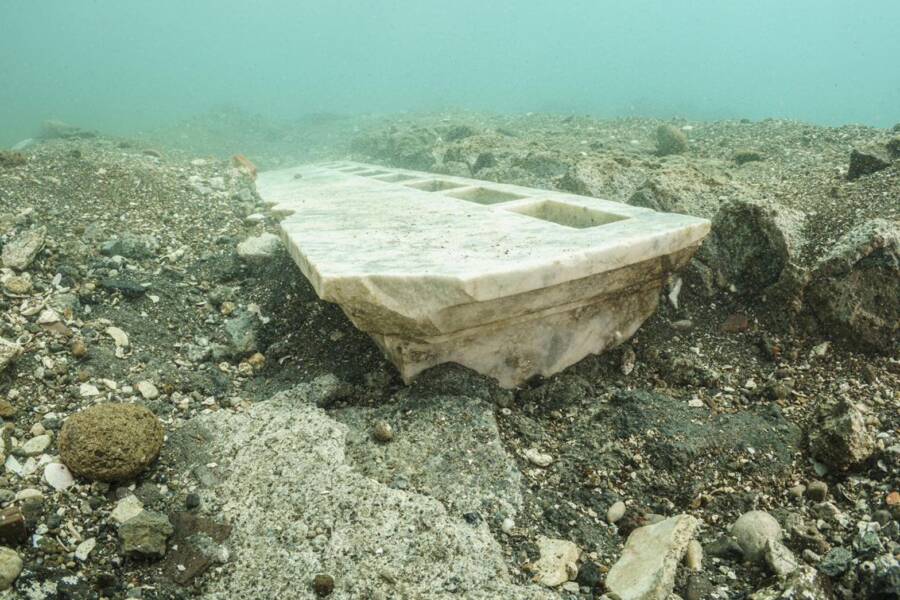Ancient Nabataean Temple Discovered Underwater Off The Coast Of Naples
The Nabataeans were a group of Arabian nomadic merchants who amassed great wealth by establishing trade routes across the region in the third century B.C.E.Ministero della CulturaArchaeologists were only recently able to determine the exact location of the ancient temple. Archaeologists in Italy recently uncovered two marble altars off the coast of Naples that were once part of the temple of the Nabataeans in the lost city of Puteoli. Puteoli was founded by the ancient Greeks around 600 B.C.E. and later became a part of the Roman Empire, serving as a vital trade center for luxury goods and grains imported from Alexandria, Egypt. Seismic activity, however, sunk portions of the once-booming trade center, and large portions of the city sank into the Gulf of Naples. Today, it is known as Pozzuoli. According to Ancient Origins, the newly discovered marble altars harken back to a time when the Nabataeans, an ancient civilization with solid ties to trade, lived freely in the Phlegrean region. Around the fourth century B.C.E., the Nabataeans settled in present-day Jordan at the site of their soon-to-be capital city, Petra. They established the Nabataean Kingdom, focusing strongly on trade and commerce. FacebookThe Gulf of Pozzuoli, part of the larger Gulf of Naples, where the ancient temple is submerged. In fact, throughout the region, the Nabataean Kingdom established trade networks that allowed it to extend its control and influence to regions across the Arabian and Sinai Peninsulas and well into the eastern part of the Mediterranean, including its neighboring islands and countries. Eventually, Petra’s population grew to over 20,000 as it became one of the region’s most central and vital trading centers. Likewise, the Nabataeans were formidable in battle, contributing enormously to their ability to remain independent despite being surrounded by the Romans, the Babylonians, and the Neo-Assyrian Empire. Though the Nabataeans initially clashed with Rome, the two eventually formed an alliance around the first century B.C.E. The Nabataeans established a trade outpost in Puteoli, the largest commercial hub in the Roman Mediterranean at the time. Here, the Nabataeans quickly established a strong commercial presence, facilitating trade between the Mediterranean Sea, the Indian Ocean, and mainland Arabia. Importing luxury goods from mainland Arabia and all but entirely dominating the trade in aromatics like frankincense and myrrh allowed the Nabataeans on the peninsula to amass a considerable amount of wealth. Unfortunately, this strong commercial presence and their alliance with Rome paled in comparison to the might of the Roman Empire, and in 106 C.E., the Roman Empire conquered Petra. After that, the culture of the Nabataeans became heavily influenced by the culture of Rome, and they converted to Christianity. Still, the discovery of marble altars from the Nabataean temple shows how strong the Nabataeans’ presence in the Phlegrean region indeed was. “Ancient Puteoli reveals another of its treasures which testifies to the richness and vastness of commercial, cultural and religious exchanges in the Mediterranean basin in the ancient world,” said Italy’s Minister of Culture, Gennaro Sangiuliano in a press statement. The discovery comes as part of a joint archaeological research project that began in 2021. The team involved in the project was formed by a partnership between the University of Campania Vanvitelli and the Scuola Superiore Meridionale in Naples, as well as the Superintendency of Archaeology, Fine Arts, and Landscape for the Metropolitan Area of Naples. For the past two years, underwater archaeologists have been scouring the underwater regions of Puteoli for ancient Roman and Nabataean artifacts. Ministero della CulturaA portion of the Nabataean marble altars found near the sunken city of Puteoli. Similar discoveries date back to the 18th century when archaeologists and historians exploring the submerged ruins of Puteoli found an altar and two cult bases with inscriptions identifying them as sites “Holy to Dushara.” Around the same time, archaeologists discovered a large bust of the deity near Pozzuoli. In the 1970s, aerial photographs of the region revealed the presence of the Nabataean temple for the first time. Still, it had been difficult for archaeologists to pin down a precise location for the ancient building. The most recent discovery finally determined that location. For more fascinating underwater discoveries, read about the 2,200-year-old Greek military ship found in Egypt’s long-lost sunken city of Thônis-Heracleion. Or, learn about the hundreds of Maya artifacts found in two separate underwater locations.

The Nabataeans were a group of Arabian nomadic merchants who amassed great wealth by establishing trade routes across the region in the third century B.C.E.
Ministero della CulturaArchaeologists were only recently able to determine the exact location of the ancient temple.
Archaeologists in Italy recently uncovered two marble altars off the coast of Naples that were once part of the temple of the Nabataeans in the lost city of Puteoli.
Puteoli was founded by the ancient Greeks around 600 B.C.E. and later became a part of the Roman Empire, serving as a vital trade center for luxury goods and grains imported from Alexandria, Egypt. Seismic activity, however, sunk portions of the once-booming trade center, and large portions of the city sank into the Gulf of Naples. Today, it is known as Pozzuoli.
According to Ancient Origins, the newly discovered marble altars harken back to a time when the Nabataeans, an ancient civilization with solid ties to trade, lived freely in the Phlegrean region.
Around the fourth century B.C.E., the Nabataeans settled in present-day Jordan at the site of their soon-to-be capital city, Petra. They established the Nabataean Kingdom, focusing strongly on trade and commerce.

FacebookThe Gulf of Pozzuoli, part of the larger Gulf of Naples, where the ancient temple is submerged.
In fact, throughout the region, the Nabataean Kingdom established trade networks that allowed it to extend its control and influence to regions across the Arabian and Sinai Peninsulas and well into the eastern part of the Mediterranean, including its neighboring islands and countries.
Eventually, Petra’s population grew to over 20,000 as it became one of the region’s most central and vital trading centers. Likewise, the Nabataeans were formidable in battle, contributing enormously to their ability to remain independent despite being surrounded by the Romans, the Babylonians, and the Neo-Assyrian Empire.
Though the Nabataeans initially clashed with Rome, the two eventually formed an alliance around the first century B.C.E. The Nabataeans established a trade outpost in Puteoli, the largest commercial hub in the Roman Mediterranean at the time.
Here, the Nabataeans quickly established a strong commercial presence, facilitating trade between the Mediterranean Sea, the Indian Ocean, and mainland Arabia. Importing luxury goods from mainland Arabia and all but entirely dominating the trade in aromatics like frankincense and myrrh allowed the Nabataeans on the peninsula to amass a considerable amount of wealth.
Unfortunately, this strong commercial presence and their alliance with Rome paled in comparison to the might of the Roman Empire, and in 106 C.E., the Roman Empire conquered Petra. After that, the culture of the Nabataeans became heavily influenced by the culture of Rome, and they converted to Christianity.
Still, the discovery of marble altars from the Nabataean temple shows how strong the Nabataeans’ presence in the Phlegrean region indeed was.
“Ancient Puteoli reveals another of its treasures which testifies to the richness and vastness of commercial, cultural and religious exchanges in the Mediterranean basin in the ancient world,” said Italy’s Minister of Culture, Gennaro Sangiuliano in a press statement.
The discovery comes as part of a joint archaeological research project that began in 2021. The team involved in the project was formed by a partnership between the University of Campania Vanvitelli and the Scuola Superiore Meridionale in Naples, as well as the Superintendency of Archaeology, Fine Arts, and Landscape for the Metropolitan Area of Naples.
For the past two years, underwater archaeologists have been scouring the underwater regions of Puteoli for ancient Roman and Nabataean artifacts.

Ministero della CulturaA portion of the Nabataean marble altars found near the sunken city of Puteoli.
Similar discoveries date back to the 18th century when archaeologists and historians exploring the submerged ruins of Puteoli found an altar and two cult bases with inscriptions identifying them as sites “Holy to Dushara.” Around the same time, archaeologists discovered a large bust of the deity near Pozzuoli.
In the 1970s, aerial photographs of the region revealed the presence of the Nabataean temple for the first time. Still, it had been difficult for archaeologists to pin down a precise location for the ancient building. The most recent discovery finally determined that location.







